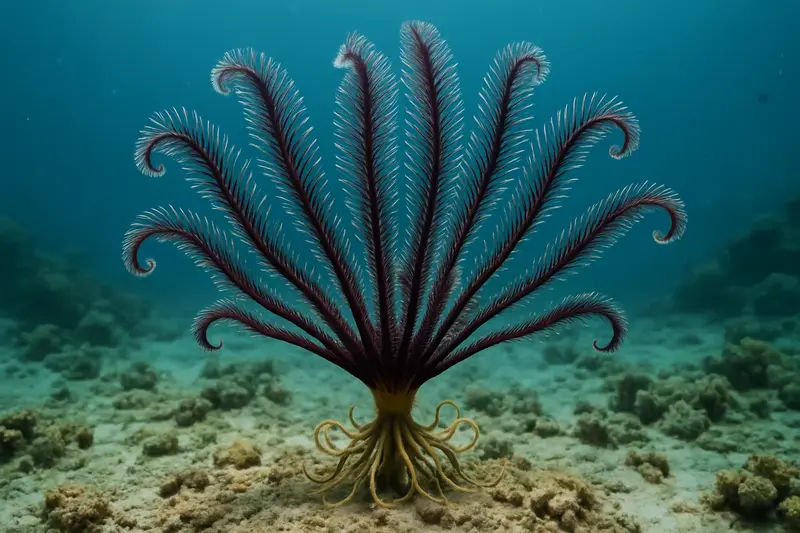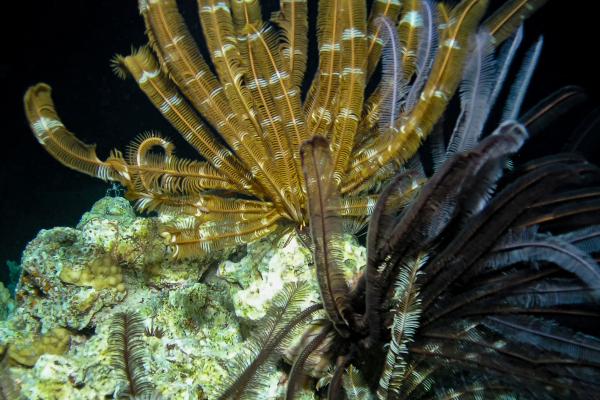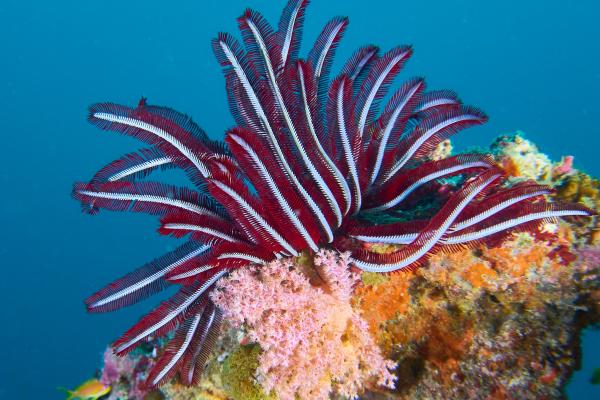Feather stars, also known as crinoids, are aquarium/52-marine-animals.html">marine animals from the phylum Echinodermata, closely related to sea stars and sea urchins. Despite their flower-like appearance and name, they are not plants, but ancient marine invertebrates.

Feather stars (class Crinoidea) are echinoderms with a central calyx (body disc) and multiple long, feather-like arms radiating outward. These animals have existed since the Ordovician period, roughly 490 million years ago, and evolved from stalked ancestors known as Holocrinidae.
After the Permian mass extinction, only a few lineages survived, giving rise to modern species. During the Cretaceous, stalked crinoids moved from shallow to deep-sea habitats, where most reside today.
Central calyx with branched, feathered arms used for feeding and movement.
Some species are stalked, attaching to hard substrates like coral or rock.
Free-moving forms can break off their stalks to escape predators.
Arm length: ranges from 1 to 35 cm; stalks can reach up to 1 meter.
Slow metabolism, allowing them to survive with minimal energy intake.
Sexually dioecious: males and females are distinct.
Strong regenerative ability: capable of regrowing lost arms or even entire crowns.

Feather stars are most commonly found in deep waters over 200 meters deep, particularly in the Western Pacific and both sides of the Atlantic Ocean.
They prefer hard surfaces for anchorage—rocks, coral, and seafloor structures. In some regions, large aggregations form “crinoid forests”, creating vibrant ecosystems that support various marine organisms.
Some unstalked species can swim or crawl slowly using arm movements, allowing them to relocate or avoid threats.
Feather stars feed by passive suspension filtering, using their mucus-coated arms to trap plankton and organic particles. These are transported by tube feet to the mouth at the top of the calyx.
Notably, they lack a true stomach. Food moves from the mouth through the esophagus, intestine, and exits via an anus located next to the mouth.
They can adjust their arm angles to optimize feeding and may scavenge or opportunistically prey on small organisms.

Dioecious species: males and females release gametes into the water.
External fertilization leads to free-floating larvae, which rely on ocean currents.
Larvae settle on a suitable substrate and undergo metamorphosis, becoming sedentary adults.
Feather stars possess excellent regenerative abilities, allowing them to regrow arms or even parts of their body—a key trait for survival in deep-sea environments.

Leptometra celtica – Found in the Atlantic; 10 arms each 7–10 cm long.
Ptilometra australis – Native to southeastern Australia; 18–20 arms lined with pinnules.
Stephanometra indica – Common in the Indo-Pacific; fan-like arm arrangement in two parallel planes.
Tropiometra carinata – Has 10 arms, up to 18 cm in length.
Metacrinus rotundus – Inhabits Japan’s western coast; resembles a feather duster with a crown of feeding arms around a central mouth.
animal tags: crinoids
We created this article in conjunction with AI technology, then made sure it was fact-checked and edited by a Animals Top editor.